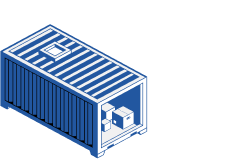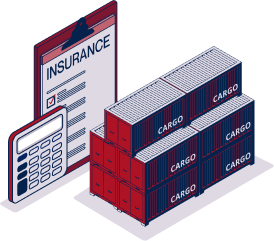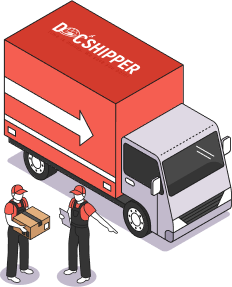Freight Shipping between Thailand and Croatia | Rates – Transit times – Duties and Taxes
Ever tried herding cats onto a cargo ship? That's easy compared to understanding freight transport rates, transit times, and customs regulations between Thailand and Croatia. This guide aims to simplify these complex aspects and shed light on the different freight options - sea, air, road, and rail. Dive deep into customs clearance procedures, duties, tariffs, and other trade-related topics without drowning in a sea of paperwork. Tailored specifically for businesses, get practical advice and useful strategies on finessing the intricate routes of international shipping. If the process still feels overwhelming, let DocShipper handle it for you! As an international freight forwarder, we’ll transform your shipping hurdles into success stories, overseeing the entire journey of your goods from origin to destination.
Which are the different modes of transportation between Thailand and Croatia?
Which are the different modes of transportation between Thailand and Croatia? Shipping goods between Thailand and Croatia can feel like solving a complex puzzle. Picture shipping agencies as travel agents, picking the best route for your goods. By sea might seem too lengthy due to the distance and the inconvenience of multiple sea routes. Air freight is direct but can be costly. A 'combo-ticket' via a mix of sea and rail could be your perfect fit. From Bangkok's bustling docks to Zagreb's interior, finding the smartest transport method is key to a smooth delivery journey, tailored to your trade needs and budget.
Need help with your shipment?
Need assistance with your shipment? Dont hesitate to contact us even for a simple question. Choose the option that suits you
Live chat with an expert Chat on WhatsApp Free Quote 24hHow can Siam Shipping help you

Sea freight between Thailand and Croatia
Ease into the ebb and flow of ocean shipping in the vibrant trade route between Thailand and Croatia. These nations, connected by sizable cargo ports, empower their buoyant industrial sectors through a network that dances across the wavy expanse of the sea. Bangko’s Laem Chabang port and Croatia’s port of Rijeka are key conduits for an elaborate ballet of containers, a testament to the economic synergy they share. While sea freight may not win a speed contest, it’s a heavyweight champion when it comes to accommodating bulk consignments, making it a go-to choice for shippers.
However, the voyage isn’t always smooth sailing. Shippers often stumble on tricky tides, finding themselves entangled in a shipload of errors when maneuvering through procedures and paperwork. The devil is indeed in the detail—and there’s an avalanche of details to keep track of. But rest assured, our practical advice in this guide will act like a skilled sailor, helping you steer clear of common missteps and chart a confident course from Thailand to Croatia. Step aboard and let’s explore this journey together—you’ll soon realize that the complexities of ocean shipping are less formidable than they appear.
Main shipping ports in Thailand
Laem Chabang Port
Located in the Bay of Bangkok, the Laem Chabang Port is the central piece of Thailand’s shipping industry, handling a shipping volume of more than 18 million TEU in 2022.
Key Trading Partners and Strategic Importance: Major trading partners include China, the United States, Japan, and several ASEAN countries. It’s a key strategic port due to its close proximity to Bangkok and the Eastern Economic Corridor, attracting many multinational corporations.
Context for Businesses: If you’re keen on expanding your business operations into Southeast Asia, particularly the booming markets of Thailand, then Laem Chabang Port is almost certainly going to play a crucial role in your logistics plans thanks to its high volume capacity and vicinity to major industrial zones.
Bangkok Port
Situated on the Chao Phraya River in the capital city, Bangkok Port dealt with a shipping volume of approximately 8.7 million TEUs in 2022.
Key Trading Partners and Strategic Importance: Bangkok Port trades primarily with neighboring countries and China, forming a crucial gateway for inland shipping.
Context for Businesses: Is your supply chain focused more on inland transportation into the Thai domestic market? Bangkok Port is ideal due to its placement within the bustling capital city and direct access to waterway transportation routes.
Map Ta Phut Port
Map Ta Phut Port is Thailand’s largest industrial port. Located in Rayong Province, it occupies a key role handling the bulk and liquid cargo, shipping volumes reaching 25.2 million tons.
Key Trading Partners and Strategic Importance: The United States, Japan, and China are important trading partners. The port’s strategic importance lies in its function as a significant hub for the petrochemical industry.
Context for Businesses: For growth strategies centred around consumer goods or petrochemicals, Map Ta Phut Port ensures smooth operation due to its specialization in bulk & liquid cargo and its plentiful terminal space.
Main shipping ports in Thailand
Laem Chabang Port
Located in the Bay of Bangkok, the Laem Chabang Port is the central piece of Thailand’s shipping industry, handling a shipping volume of more than 18 million TEU in 2022.
Key Trading Partners and Strategic Importance: Major trading partners include China, the United States, Japan, and several ASEAN countries. It’s a key strategic port due to its close proximity to Bangkok and the Eastern Economic Corridor, attracting many multinational corporations.
Context for Businesses: If you’re keen on expanding your business operations into Southeast Asia, particularly the booming markets of Thailand, then Laem Chabang Port is almost certainly going to play a crucial role in your logistics plans thanks to its high volume capacity and vicinity to major industrial zones.
Bangkok Port
Situated on the Chao Phraya River in the capital city, Bangkok Port dealt with a shipping volume of approximately 8.7 million TEUs in 2022.
Key Trading Partners and Strategic Importance: Bangkok Port trades primarily with neighboring countries and China, forming a crucial gateway for inland shipping.
Context for Businesses: Is your supply chain focused more on inland transportation into the Thai domestic market? Bangkok Port is ideal due to its placement within the bustling capital city and direct access to waterway transportation routes.
Map Ta Phut Port
Map Ta Phut Port is Thailand’s largest industrial port. Located in Rayong Province, it occupies a key role handling the bulk and liquid cargo, shipping volumes reaching 25.2 million tons.
Key Trading Partners and Strategic Importance: The United States, Japan, and China are important trading partners. The port’s strategic importance lies in its function as a significant hub for the petrochemical industry.
Context for Businesses: For growth strategies centred around consumer goods or petrochemicals, Map Ta Phut Port ensures smooth operation due to its specialization in bulk & liquid cargo and its plentiful terminal space.
Main shipping ports in Croatia
Port of Rijeka
Location and Volume: Situated on the North Adriatic Sea, the Port of Rijeka is regarded as a gateway to Central and Southeast Europe, boasting a shipping volume of over 600,000 TEUs.
Key Trading Partners and Strategic Importance: With strong ties to key trade players like Italy, Germany and Slovenia, this port is strategically important for international trade, especially serving as a significant car import hub.
Context for Businesses: If your business is car-related or aims to tap into central European markets, considering the thriving commerce at the Port of Rijeka could provide a strategic advantage.
Port of Ploče
Location and Volume: The Port of Ploče, located in the southeastern Adriatic Sea, serves as an instrumental node in linking Croatia with Bosnia and Herzegovina. It handles a shipping volume of approximately 7.5 million tons annually.
Key Trading Partners and Strategic Importance: This port has significantly established trade relations with Turkey, Greece and numerous Mediterranean countries. The port’s strategic advantage is its capacity to handle bulk cargo, making it an essential terminal for grains, fertilizers, and coal.
Context for Businesses: If your company deals with bulk cargo or aims to extend operations to near Eastern countries, the Port of Ploče may meet your strategic goals due to its extensive handling capabilities and strategic location.
Port of Split
Location and Volume: Nestled in the eastern shore of the Adriatic Sea, the Port of Split holds a significant position for domestic and international maritime traffic with an annual volume of approximately 5 million passengers.
Key Trading Partners and Strategic Importance: Major trading partners include Italy and other coastal countries lining the Adriac Sea. The port’s strategic importance lies in its significant passenger operations, which makes it an efficient hub for freight cargo as well.
Context for Businesses: If fast and efficient passenger and cargo ferry routes to Italy and Eastern Europe are crucial to your company, taking advantage of the Port of Split’s established networks could streamline your logistics.
Port of Zadar
Location and Volume: The Port of Zadar, positioned in the centre of the Adriatic coast, facilitates both passenger and cargo connections, annually superseding 3.5 million tons of cargo.
Key Trading Partners and Strategic Importance: The port is tied to trading activities with Montenegro, Albania, and Greece. It notably hosts a ferry route that serves as a strategic link to Ancona, Italy.
Context for Businesses: If you’re focusing on expanding your trade routes to southern Europe and the Balkans, the Port of Zadar, with its notable ferry link, could be a necessary inclusion in your shipping strategy.
Port of Dubrovnik
Location and Volume: Placed in the deep south of the Adriatic Sea, the Port of Dubrovnik leads as a terminal for passenger and cargo vessels with an annual handling of around 4 million passengers.
Key Trading Partners and Strategic Importance: The port holds robust trading relationships with southern European and Mediterranean countries, Spain being a notable partner. Its strategic importance arises from cruise ships operations, representing an opportunity for businesses dealing with voyage-related goods.
Context for Businesses: If your enterprise revolves around tourism or transport to Mediterranean countries, capitalizing on the Port of Dubrovnik’s energetic cruise ship operations could boost your business.
Should I choose FCL or LCL when shipping between Thailand and Croatia?
Contemplating between consolidation and a full container FCL for your sea freight from Thailand to Croatia? This pivotal decision can have significant consequences on your shipping costs, delivery times, and overall process success. Dive into our comprehensive comparison of Full Container Load (FCL) and Less than Container Load (LCL), or consolidation shipping. We aim to empower you with the necessary insights to make an informed decision tailored to your specific shipping needs. Welcome to a more strategic, efficient, and successful shipping experience. Let’s get started!

Full container load (FCL)
Definition: Full Container Load (FCL) shipping involves reserving a full container (20'ft or 40'ft) for your goods on a vessel voyage, a reliable choice for large shipment volumes. When to Use: If your cargo volume surpasses 13/14/15 CBM, FCL shipping becomes a cost-effective and safe option. This method seals your container from the origin in Thailand to the destination in Croatia, dramatically reducing chances of damage during transit. Example: Consider a Thai toy manufacturer exporting plush toys to a Croatian retailer. The toys fill up more than a 20'ft container, making FCL the best option. By selecting FCL, the manufacturer can efficiently and securely ship the large volume of toys using a single, exclusive container. Cost Implications: While FCL shipping does necessitate a higher upfront cost for securing the full container, it becomes economically savvy with higher volumes. The per unit shipping costs decrease as the volume increases. To understand the real cost number, requesting an FCL shipping quote from an experienced freight forwarder is recommended. The quote will include all expenses, offering a transparent view of the total FCL shipping cost.

Less container load (LCL)
Definition:LCL (Less than Container Load) shipping refers to a consolidated shipping method where your cargo is grouped with others to fill a full container, ideal for smaller shipments. When to Use:This method is perfect when the cargo is less than around 15 CBM. It is a more affordable and flexible approach for businesses shipping low volume, as you only pay for the space your goods occupy. Example:Imagine a Thai furniture manufacturer shipping a small batch order of 10 CBM of wooden chairs to Croatia; using LCL shipment would, in this case, be ideal and more cost-effective. Cost Implications:Compared to Full Container Load (FCL) shipping, LCL freight tends to have a higher price per cubic meter, but the overall cost might still be less for smaller cargo volumes. That's because you avoid the expenses associated with unused container space in FCL. However, remember that there may be additional handling fees as multiple LCL shipments are loaded into and out of a single container.
Hassle-free shipping
Overwhelmed by shipping options between Thailand and Croatia? DocShipper can make the process a breeze! Our ocean freight specialists will guide you through the consolidation vs. full container decision, considering important elements such as cargo volume, your budget, and nature of goods. Capitalize on our expertise to ensure hassle-free and cost-efficient shipping. Get in touch for a free shipping estimate today - We streamline, you grow!
How long does sea freight take between Thailand and Croatia?
Shipping goods from Thailand to Croatia by sea freight typically takes about 30 to 60 days. However, this can vary based on several factors including specific ports used, the weight and type of goods being shipped. It’s recommended to get a tailored quote for a precise timeframe from an experienced freight forwarder like DocShipper.
Here’s a breakdown of average transit times:
Thailand Port Croatia Port Average Transit Time Laem Chabang Rijeka 33 daysHow much does it cost to ship a container between Thailand and Croatia?
Establishing an exact cost for shipping a container from Thailand to Croatia might be as tricky as predicting waves in the open sea. Ocean freight rates, just like waves, are subject to constant changes, influenced by a myriad of variables such as the Point of Loading, the Point of Destination, your preferred carrier, the nature of your goods, and even monthly market fluctuations. Pinning down the exact shipping cost would be as fleeting as catching sea foam. But fear not, you’re not adrift in this sea of uncertainties. Our experienced shipping specialists are ready to cast a lifeline, providing tailored quotes on a case-by-case basis to ensure you net the best rates available. Set sail with us and let us navigate these fluctuating tides together!
Special transportation services
Out of Gauge (OOG) Container
Definition: Out of Gauge (OOG) containers are optimized for transporting cargo that exceeds standard container dimensions. Suitable for: Unusually large or bulky items, such as machinery parts, construction equipment, and other oversized goods. Examples: Transporting large yachts from Thailand’s shipyards or oversized equipment for the energy sector in Croatia could involve an OOG container. Why it might be the best choice for you: If your goods exceed the dimensions of ordinary containers, an OOG container offers the flexibility to accommodate your out of gauge cargo safely and efficiently.
Break Bulk
Definition: Break bulk refers to goods that must be loaded individually, and not in containers, often due to their large size. Suitable for: Non-containerized goods, heavy machinery, pulping logs, and other larger-scale resources. Examples: If you’re shipping factory components from Thailand to Croatia, or the other way around, you might opt for break bulk shipping due to their size and weight. Why it might be the best choice for you: For shipments that can’t be contained in standard shipping containers due to their size, break bulk shipping can be an ideal solution.
Dry Bulk
Definition: Dry bulk cargo involves loose cargo load, like grains, that are loaded directly into the vessel’s hold. Suitable for: shipments of large quantities of single commodities, such as coal or grain. Examples: If shipping rice from Thailand or wheat from Croatia in substantial quantities, dry bulk would be the way to go. Why it might be the best choice for you: If you’re looking to transport substantial quantities of one type of commodity, dry bulk shipping can be a cost-efficient and effective way to do so.
Roll-on/Roll-off (Ro-Ro)
Definition: Roll-on/Roll-off (Ro-Ro) involves cargo that rolls onto a ro-ro vessel and off at its destination. Suitable for: Cars, trucks, semi-trailer trucks, trailers, or railroad cars. Examples: If you’re a car manufacturer looking to get your vehicles from Thailand to Croatia, the best option might be a Ro-Ro shipment. Why it might be the best choice for you: Ro-Ro shipping ensures your vehicles can be easily loaded and unloaded using their own wheels, which can significantly reduce handling costs.
Reefer Containers
Definition: Reefer containers are refrigerated containers used for goods requiring temperature control. Suitable for: Perishables like fruits, vegetables, dairy products, and other temperature-sensitive goods. Examples: If you’re exporting food commodities, like seafood from Thailand or cheese from Croatia, the reefer containers will be your best friend. Why it might be the best choice for you: If you’re dealing with temperature-sensitive goods, reefer containers maintain the necessary cool or frozen state during transport, ensuring your products reach their destination in pristine condition.
At DocShipper, we’re devoted to providing tailored solutions that fit your shipping needs. Feel free to contact us for a free shipping quote in less than 24 hours. We’re here to simplify your shipping logistics from Thailand to Croatia!

Air freight between Thailand and Croatia
Air freight between Thailand and Croatia: Fast, reliable, and ideal for shipping small, high-value goods, like delicate electronics or trendy designer wear. Imagine ordering a designer watch, it could be boxed in Bangkok in the morning and unboxed in Zagreb by evening, all thanks to the speed of air freight.
However, efficiency comes at a cost, both monetarily and tactically, and many businesses stumble here. It’s like cooking a gourmet meal without a recipe – you might know the ingredients but without the precise measurements and steps, you’re likely to end up with a kitchen disaster. Same goes with air freight. Several businesses make a snap decision to ship goods by air without factoring in all the elements — misunderstandings about the ‘chargeable weight’ can add unexpected costs, and not knowing best practices can inflate the bill even further. But worry not, our guide will help you avoid these common pitfalls and streamline your shipping process.
Air Cargo vs Express Air Freight: How should I ship?
Choosing between Air Cargo and Express Air Freight from Thailand to Croatia? Think of it like this: Air Cargo’s like booking a seat on a commercial flight, while Express is more of a private jet, dedicated solely to your shipment. In this guide, we’ll unravel these options, weigh their pros and cons, and help you decide which one caters best to your business needs. Tackling this decision can be tricky, but with the right information, you’ll be shipping confidently in no time.
Should I choose Air Cargo between Thailand and Croatia?
When shipping goods from Thailand to Croatia, air cargo can offer cost effectiveness and reliability. Airlines that provide such service include Thai Airways and Croatia Airlines. They have regular schedules, ensuring predictability though longer transit times. Interestingly, from around 100/150 kg (220/330 lbs) of cargo, this mode becomes more attractive. Thai Airways and Croatia Airlines provide comprehensive services and details suited for diverse needs. If budget is your concern, air shipping could be a wise choice to balance cost and delivery time.

Should I choose Express Air Freight between Thailand and Croatia?
Express air freight, relying on dedicated cargo planes sans passengers, offers advantages for transporting lighter, compact cargo. If your shipment between Thailand and Croatia is under 1 CBM (cubic meter) or 100/150kg (220/330 lbs), consider this option. It’s fast, ensuring your goods arrive rapidly and securely. Pioneers in this specialized service like FedEx, UPS, or DHL promise reliability and global coverage. Opting for express air freight could result in smoother customs clearance too, providing you peace of mind. So, for swift, reliable shipping with less hassle, this might be the perfect choice for your business.

Main international airports in Thailand
Suvarnabhumi Airport (BKK)
Cargo Volume: With an annual freight volume of over 1.3 million metric tons, Suvarnabhumi Airport ranks as one of the busiest cargo airports in Southeast Asia. Key Trading Partners: Major trading partners include China, Japan, and the USA, focusing mainly on machinery, electronics, and perishable goods. Strategic Importance: As Bangkok’s primary airport, Suvarnabhumi Airport is a vital hub for air traffic in Southeast Asia. Its massive cargo terminal fosters large-scale freight handling, providing crucial links to industries from manufacturing to agriculture. Notable Features: The airport boasts a 570,000 sqm cargo terminal equipped with state-of-the-art technology, ensuring efficient handling and storage of goods. It also enables fast clearance of goods with its on-site customs facility. For Your Business: If you’re targeting partners in Asia and beyond, Suvarnabhumi Airport’s established network might be an efficient choice for your air cargo requirements. Its robust infrastructure and smooth cargo handling processes ensure timely delivery, potentially minimizing disruptions in your supply chain.
Don Mueang International Airport (DMK)
Cargo Volume: While having lower cargo volume compared to Suvarnabhumi, Don Mueang Airport still exhibits significant movement — over 130,000 metric tons annually. Key Trading Partners: Key trading connections include Asian countries, with Chinese, Japanese, and Korean companies playing important roles. Strategic Importance: As another of Bangkok’s airports, Don Mueang holds historical significance and continues to play a significant part in the Thai aviation industry, specifically in low-cost carrier operations. Notable Features: With its dedicated cargo terminal, this airport handles an array of freight types including textiles, electronics, and automotive components. For Your Business: If you’re a company dealing with more cost-effective commodities, Don Mueang’s substantial low-cost carrier operations can possibly offer competitive rates to boost your bottom line.
Phuket International Airport (HKT)
Cargo Volume: With an annual cargo turnover of tens of thousands of metric tons, it may be lower than Bangkok’s airports but its strategic location ensures it remains an active player. Key Trading Partners: Phuket’s primary trading partners involve Asian and European markets with a particular emphasis on perishable goods such as seafood and fruit. Strategic Importance: As the gateway to Southern Thailand, Phuket International Airport’s location aids in connecting the island to key markets, both regionally and globally. Notable Features: The airport has facilities for refrigerated storage, making it ideal for perishable and sensitive cargo. For Your Business: If your products require special handling – such as seafood exports – Phuket’s specialized facilities can facilitate damage-free and quality-controlled transportation. Its location also offers access to Southern Thai markets and beyond.
Remember, the best airport for your business will largely depend on the nature of your cargo, destination markets, and specific business strategies.
Main international airports in Croatia
Zagreb Airport
Cargo Volume: Zagreb Airport, also known as Franjo Tuđman Airport, handles around 13,000 tons of cargo annually, making it the largest cargo airport in Croatia. Key Trading Partners: The main trading partners include Germany, Italy, Slovenia, Austria, and Bosnia and Herzegovina, pointing to its strong connections within Europe. Strategic Importance: Located in the capital city of Croatia, Zagreb Airport serves as a key gateway for cargo entering and leaving the country. Its central location makes it easily accessible by road for further distribution throughout the country. Notable Features: The airport’s modern facilities include a dedicated 2000 m2 cargo terminal, which allows it to handle a wide variety of goods with efficiency. Additionally, it has a direct cargo-only flight connection with Leipzig, an important European cargo hub. For Your Business: Zagreb Airport’s strong European connections and robust cargo facilities make it an effective option if your business is centered around trade within Europe. Its cargo-only flight connections may also enable faster, more direct shipments.
Pula Airport
Cargo Volume: Pula Airport handles a smaller volume of cargo, averaging around 1,000 tons annually. Key Trading Partners: Key trading partners include Italy, Germany, Austria, and Slovenia. Its proximity to Italy makes it a significant point for Italy-Croatia trade. Strategic Importance: Situated on the Istrian peninsula, Pula Airport is strategically positioned for trade routes within the Adriatic and Mediterranean Sea areas. Notable Features: Though smaller in scale, Pula Airport features modern facilities, including a temperature-controlled storage area, which is ideal for perishable goods. For Your Business: If your business specializes in perishable goods or focuses on Mediterranean markets, Pula Airport’s location and facilities could suit your shipping strategy. Its smaller size might mean less congestion and potentially faster processing times.
Split Airport
Cargo Volume: Split Airport handles a moderate volume of cargo, with figures on the rise in recent years and reaching about 2,000 tons annually. Key Trading Partners: Key trading partners for this airport include Germany, Italy, Austria, and France. Strategic Importance: As the second-largest city in Croatia, Split plays a strategic role in handling cargo that aims at reaching the southern parts of Croatia and the Dalmatian coast. Notable Features: Split Airport has been recently renovated with updated cargo facilities, reflecting its growing importance in the cargo sector. For Your Business: If your shipping routes involve southern Croatia or Dalmatian markets, Split Airport could be an optimal choice due to its strategic location and updated facilities.
Unfortunately, I can’t provide the official links to these airports as they are not available as per the context. These overviews should offer some guidance in choosing the right cargo airport for your business in Croatia.
How long does air freight take between Thailand and Croatia?
The average shipping time via air freight between Thailand and Croatia is around 3-6 days. However, keep in mind these transit times can change depending on aspects such as the specific airports in use, the weight of the consignment, and the nature of goods being transported. Remember, if you need the most accurate times, it’s wise to consult with an experienced freight forwarder like DocShipper.
How much does it cost to ship a parcel between Thailand and Croatia with air freight?
Shipping costs via air freight from Thailand to Croatia can vastly range, with a broad average between $3 to $8 per kg. However, many factors affect this, including proximity to departure and arrival airports, parcel dimensions, weight, and type of goods. Therefore, pinpointing an exact price isn’t straightforward. But don’t fret, our team is committed to offering the best possible rates tailored to your unique needs. We assess each situation individually to ensure you get the most competitive quotes. Interested? Contact us to receive a free quote in less than 24 hours!
What is the difference between volumetric and gross weight?
Gross weight refers to the actual physical weight of the shipment, the raw weight of both your goods and the packaging. Volumetric weight, on the other hand, represents the amount of space your package takes up on the airplane.
For air cargo shipments, the volumetric weight is calculated as (Length x Width x Height in cm) / 6000. Say you’re shipping a box from Thailand to Croatia with dimensions 150cm x 75cm x 50cm. The volumetric weight becomes (150 x 75 x 50) / 6000 = 93.75 kg or around 207 lbs.
Gross weight is more straightforward; if your package weighs 80 kg, it is also 176 lbs.
For Express Air Freight, the divisor changes; the formula becomes (Length x Width x Height in cm) / 5000. Using the same dimensions, the volumetric weight computes as (150 x 75 x 50) / 5000 = 112.5 kg or roughly 248 lbs.
Freight charges hinge on these calculations as carriers charge on the basis of the higher weight – gross or volumetric – to maximize efficiency and optimize the space. So being aware can help you understand your shipping costs and manage your budget better.

Door to door between Thailand and Croatia
Navigating the world of logistics? Door to Door shipping is your pal! It’s all about a seamless journey from Thailand all the way to Croatia, with your shipment picked up and delivered right at the doorstep. The big wins? Time saved and less hassle for you. Sounds promising, right? Let’s dive in and explore this fascinating shipping method.
Overview – Door to Door
Shipping goods from Thailand to Croatia? Door to Door shipping might be your stress-free ticket! This popular solution helps you bypass the complexities associated with the logistics process. Imagine no more wrangling with customs clearance or coordinating transport modes! It’s not all rosy though; this option might be more expensive and less flexible than others. Despite the drawbacks, our clients often choose Door to Door shipping for the peace of mind it provides. After all, worry-free logistics is priceless! Stay tuned in this guide for more practical insights into shipping bliss.
Why should I use a Door to Door service between Thailand and Croatia?
Ever juggled fire with one hand while balancing on a unicycle? Yep, figuring out the logistics of shipping goods from Thailand to Croatia could feel just as tricky. But here’s the good news: Door to Door service can be a lifesaver, turning your shipping process into a smooth sailing journey across the seas.
Firstly, it streamlines the entire process by picking up your goods from your doorstep right in Thailand and delivering them to the desired location in Croatia. No more coordinating with multiple service providers or fretting over gaps in the logistics chain!
Secondly, if you’re racing against time, this service ticks all the right boxes. With expert handling and proven pathways, Door to Door service ensures your urgent shipments reach their destination without a hitch. It’s your very own time-turner in the world of shipping!
Thirdly, got complex cargo? No problem! With specialized care for intricate cargo, your goods are handled like a glass bauble on a Christmas tree – with care, precision, and absolute safety.
Fourthly, trust us when we say – the convenience is unparalleled. The worry of handover, transition, and trucking until the final destination? Poof, gone!
Lastly, fewer points of contact significantly reduce the risk of damage, loss, or delay, leaving you with peace of mind and a seamless shipping experience.
So, why use a Door to Door service? The better question is – why not? After all, who wouldn’t prefer a tranquil sail, over juggling fiery logistics nightmares!
DocShipper – Door to Door specialist between Thailand and Croatia
Journey into the world of hassle-free logistics with DocShipper’s door-to-door shipping service from Thailand to Croatia. With a team of experienced domain professionals at the helm, from packaging to customs, from air to sea – every stage is meticulously managed. Delight in the calm of knowing that a dedicated Account Executive is managing your needs. Reach out and get a no-obligation cost estimate within 24 hours, or if you prefer, connect with our consultants for free advice anytime. Dive into the seamless, stress-free freight-forwarding experience you’ve always desired with DocShipper!

Customs clearance in Croatia for goods imported from Thailand
Navigating the labyrinth of customs clearance – the process of importing goods from Thailand to Croatia – can feel daunting. Beyond organizing transport, unexpected fees and charges often catch businesses off guard. Equally critical are customs duties, taxes, quotas, and licenses for your specific goods. Missteps could leave your shipment marooned at customs – an expensive hiccup. The following sections will guide you through this intricate maze. Remember, DocShipper stands ready to walk alongside you through this complex process, managing goods of any type, from anywhere. Contact our team with your goods’ origin, value, and HS code for a precise estimate. Let’s turn this daunting journey into a smooth voyage, together.
How to calculate duties & taxes when importing from Thailand to Croatia?
Embarking on the journey to import goods from Thailand to Croatia means grappling with a host of customs duties and taxes – a task that might seem daunting, but with the right knowledge, can be handled with ease. The import duty calculation involves multiple components, including the HS Code, Applicable Tariff Rate, Customs Value, and the country of origin. Other taxes and fees may also apply, adding to the overall cost of your shipment.
The first step in this process is to pinpoint the exact country where your goods were manufactured or produced. This is crucial because it directly influences the calculation of the customs duties and drives the future stages of the import process. Armed with this knowledge, you’re one step closer to successfully navigating your shipping adventure.
Step 1 – Identify the Country of Origin
Identifying the country of origin, often something assumed, actually carries far-reaching implications that are anything but basic. Here are five reasons why it matters.
Firstly, the origin determines if trade agreements apply. For our case, Thailand and Croatia have agreements under the EU-Thailand Free Trade Agreement. If your goods fall under this agreement, customs duties can reduce or even vanish.
Second, some items have restrictions based on origin. Certain agricultural goods from Thailand might face limitations to protect Croatia’s local industry.
Now, onto the third reason – import quotas. Origin dictates how much of a product can enter Croatia. Be aware of this to deter potential hold-ups.
Next, the accuracy of import records. Providing the exact origin ensures transparency, maintaining trust with customs authorities and minimizing potential auditing issues.
Lastly, consumer preferences. For example, ‘Made in Thailand’ could be a selling point for products like silk or jasmine rice.
Let’s wrap up, always double-check the Country of Origin before proceeding with the HS code. The unnoticed details often lead to the smoothest shipping experience.
Step 2 – Find the HS Code of your product
The Harmonized System (HS) Code is a part of a globalized truly international system of names and numbers used to classify and define traded products. Developed by the World Customs Organization, it is often required to clear customs and is critical at various stages in the supply chain, including when determining transportation charges, controlling goods, collecting internal taxes, and preparing shipping documents, among other instances.
Typically, the simplest way to find the HS code for your product is to ask your supplier. They’re likely very familiar with the products they’re importing and the corresponding regulations.
However, if that’s not a feasible option for you, we’ve got a simple step-by-step process ready for you. First, access an HS lookup tool, such as the Harmonized Tariff Schedule. Once there, simply input the name of your product in the search bar. After executing the search, check the ‘Heading/Subheading’ column, where you’ll locate the specific HS code applicable to your product.
A word of caution is vital to note here. Accuracy is paramount when determining an HS code. A wrong code could lead to customs delays, potential fines, and other unwanted hiccups in your shipping process.
Here’s an infographic showing you how to read an HS code – remember, every segment of the code has its specific meaning and corresponds to specific details about your product.

Step 3 – Calculate the Customs Value
Understanding customs value might seem tricky, but let’s break it down. Simply put, it’s the total value of your goods, inclusive of the cost of the items, international shipping charges, and the insurance cost. So, it’s not just the price tag of your product! Why does it matter? Well, it’s based on this CIF value that your import duties to Croatia will be calculated.
Let’s take an example to make it clear. Suppose you’re importing goods from Thailand worth $1000. The international shipping costs are $200, and the insurance is $50. Here, your customs value would be $1000 (cost of goods) + $200 (shipping) + $50 (insurance) = $1250. Croatia customs will then use this $1250 as a base to calculate your import duties. The higher the customs value, the higher the import duties. So, every dollar counts!
Step 4 – Figure out the applicable Import Tariff
An import tariff is a tax imposed by a country on goods imported from abroad. It serves to regulate trade, protect domestic industries, and collect government revenue. Croatia, as a member of the European Union, uses the Combined Nomenclature (CN) system for its tariffs, a detailed method for classifying goods.
Use the TARIC System – European Customs to identify tariffs. Enter the HS code from earlier and select Thailand as the origin. The system provides the tax duties and charges for your product.
Let’s consider a practical example: You’re importing wooden furniture (HS code 940330) from Thailand. Your CIF (Cost, Insurance, and Freight) is $10,000. Enter ‘940330’ in the TARIC system, resulting in a duty rate of 2.7%. To calculate the import duties, apply this rate to your CIF cost: $10,0002.7/100 = $270. Hence, your import duties are $270.
Knowing the applied tariff allows for more accurate cost predictions, minimizing surprises upon goods arrivals, ensuring a smoother shipping process, and ultimately a more predictable bottom line.
Step 5 – Consider other Import Duties and Taxes
Handling import duties and taxes can be a complex and often daunting aspect of international trade – but it doesn’t have to be. Now, beyond the standard tariff rate, you might face other import charges, dependent on your commodity’s nature and its origin.
Take an alcoholic beverage, for example. If you’re importing wine from Thailand into Croatia, you’ll confront an excise duty, an extra charge levied on specific goods susceptible to excise, like tobacco, spirits, or fuel. The rates, however, can vary widely.
You may also face anti-dumping taxes. These are imposed when a foreign supplier sells goods significantly below market price, possibly damaging the domestic industry in Croatia. For instance (remember, it’s just an example), if a Thai supplier is offloading steel for $100 per ton, which is significantly below the fair price, the Croatian customs may impose an anti-dumping duty to level the field.
But perhaps the most significant extra tax is the Value-Added-Tax (VAT). It’s a consumption tax levied on a product at every point of sale where value has been added. For instance, if you’ve imported goods worth $10,000, and the VAT rate is 25% (illustrative purposes), your import VAT payable would be $2,500.
Understanding and effectively managing these duties and taxes can make a significant difference, improving your bottom line, and saving you potential headaches down the line. As always, it pays to stay informed and prepared!
Step 6 – Calculate the Customs Duties
Calculating your Customs Duties for goods shipped from Thailand to Croatia involves a simple yet crucial formula incorporating the customs value, VAT, and possible anti-dumping taxes.
Firstly, imagine you’re importing goods valued at $10,000 with a duty rate of 10%. The customs duty would be $1000 ($10,00010%), with no VAT applied.
Secondly, let’s say you’re importing goods valued at $12,000 with a duty rate of 5% and VAT at 25%. Customs duty would be $600 ($12,0005%) and VAT is on top of the sum of the value and duty, which would be $3125 (25% of $12,600), totaling $3725.
Lastly, for goods valued at $15,000 with a duty rate of 5%, VAT at 25%, anti-dumping taxes of $2000, and an Excise Duty of $500. Your customs duty would be $750 ($15,0005%) and VAT would be $4425 (25% of $17,750), leading to a total of $7175.
Remember, miscalculations can lead to overpayment, delays, or penalties. To ensure accurate calculations, consider reaching out to DocShipper. Our experienced team handles hundreds of customs clearances, ensuring you pay the right amount. Get a free quote in less than 24 hours, and let us deal with the complexities while you focus on growing your business.
Does DocShipper charge customs fees?
While DocShipper, as a licensed customs broker in Thailand and Croatia, handles customs clearance, any applied customs duties are not charged by us but go directly to the government. We only charge for the customs clearance services. To ensure transparency, we provide documentation from the customs office that clearly shows you’re only paying government-imposed charges. It’s like the fee for getting your car serviced versus the cost of new parts; one goes to the mechanic, the other pays for the parts from the manufacturer.
Contact Details for Customs Authorities
Thailand Customs

Official name: Customs Department, Ministry of Finance, Kingdom of Thailand. Official website: www.customs.go.th/
Croatia Customs

Official name: Customs Administration of the Republic of Croatia Official website: carina.gov.hr/
Required documents for customs clearance
Tangled in red tape of international shipping? You’re not alone. Grasping key documents like the Bill of Lading, Packing List, Certificate of Origin, and Certificates of Conformity can make or break your customs experience. Be prepared to breeze through with our clear breakdown. No more customs headaches!
Bill of Lading
Routing goods from Thailand to Croatia? Your vital companion here is the Bill of Lading, the shipping world’s golden ticket. It’s essentially a legal agreement between you, the shipper, and your carrier, authorizing transfer of ownership for your goods on arrival.
Didn’t think shipping could go digital? Think again. Electronic or ‘telex’ release lets you handle your Bill of Lading online, slashing paperwork and speeding up delivery. It’s perfect if you’re after efficiency and convenience.
Don’t forget about the Air Waybill (AWB) for air cargo. Like a Bill of Lading, it preserves your rights while your goods are airborne. In a nutshell, it means safety and peace of mind – because we know those are at the top of your shipping checklist. Safe journeys!
Packing List
Think of the Packing List as the roadmap of your shipment from Thailand to Croatia, painting a crystal-clear picture of what’s inside your cargo – vital for both air and sea freight. It’s created by you, the shipper, and it ought to be as precise as possible. Is it electronics components you’re shipping in that crate? Then list each component. Sending artisanal soap from Chiang Mai? Make each scent count. Customs officials rely heavily on this list – it’s how they validate the goods being transported. There was a business, for instance, shipping machinery parts, but due an inaccurate Packing List, they faced detrimental custom delays. Avoid such snags and make sure your shipment sails smoothly through customs. Accuracy is shipping’s best friend!
Commercial Invoice
Navigating the customs landscape between Thailand and Croatia? Your Commercial Invoice is a passport for your goods. This vital document verifies the value of your merchandise and is crucial for calculating duties. It should detail product descriptions, quantity, value, and the parties involved in the transaction. When shipping that specialty Thai jasmine rice to your buyer in Zagreb, ensure your invoice’s details match with other shipping documents to avoid customs hiccups. A clear, accurate invoice expedites clearance, preventing distressing delays. A pro tip: Include the correct Harmonized System code; it’s a globally accepted product classification method that smooths your cargo’s journey. Remember, precision is key!
Certificate of Origin
When shipping goods from Thailand to Croatia, capturing the correct details on a Certificate of Origin is paramount. This crucial document testifies that your product was genuinely made in Thailand, and it’s what helps customs officials determine if your shipment qualifies for preferential duty rates. Suppose you’re exporting Thai silk scarves, highlighting ‘Made in Thailand’ on the certificate will open doors to tariff discounts. However, if your scarves were woven with non-Thai silk, you’d lose that privilege. So, be meticulous with your paperwork and ride the wave of benefits that trade agreements offer. Remember, being precise with your country of manufacture can save you a significant chunk on customs duty and streamline your shipping process.
Certificate of Conformity (CE standard)
When shipping goods from Thailand to Croatia, securing a Certificate of Conformity (CE standard) is essential for smooth customs clearance. This document certifies your goods comply with the European Union’s safety, health, and environmental protection standards. In a nutshell, it’s your item’s passport for admission into the EU marketplace, including Croatia. This isn’t to be confused with quality assurance, which refers to operational processes within your company. Unlike the US standards focused on a case-by-case examination, the CE mark applies to whole product categories. To avoid regulatory snags, ensure your goods sport the necessary CE marking. Ignoring this can lead to shipment delays, additional costs, or even denial of entry. So, diligently verify the classification of your goods and get the CE certification beforehand for a hassle-free shipping experience.
Your EORI number (Economic Operator Registration Identification)
When shipping goods from Thailand to Croatia, it’s essential to have your EORI number in place. This unique ID is your golden ticket for making customs clearance a breeze. You’re not just a random entity but a recognized trader to the EU. Without this number, your shipment might hit a standstill or even get overlooked in the bustling sea or air cargo traffic. Plus, it’s like a passport that weaves a clear path of your imports or exports within the EU. Registering might seem like just another administrative step, but it’s a shortcut worth taking. And remember, in a game where time is money, having your EORI number can save you both. Happy shipping!
Get Started with Siam Shipping
Prohibited and Restricted items when importing into Croatia
Tackling import regulations for Croatia? It’s tricky, isn’t it? Ensuring your cargo aligns with Croatia’s customs laws governing prohibited and restricted goods is critical. Nobody wants the headaches of denied entries, hefty penalties, or seized goods. Let’s dive into the specifics to keep your freight sailing smoothly.
Are there any trade agreements between Thailand and Croatia
Currently, there’s no Free Trade Agreement (FTA) or Economic Partnership Agreement (EPA) between Thailand and Croatia. However, trade relations are continually improving, which opens new opportunities for your business. For instance, the Thailand-Croatia Trade Association, established to enhance commercial ties, shows promise for future benefits. Also, an upcoming infrastructure project connecting Asian and European rail lines bears potential for increased trade efficiency. So, don’t let the absence of formal agreements discourage you! Your shipping ventures between these countries could still be very fruitful.
Thailand – Croatia trade and economic relationship
In the historical panorama, the Thailand-Croatia economic relationship has seen steady growth. Delegations from both countries have bolstered the bilateral ties through frequent visits, focusing on areas like tourism, shipbuilding, and agriculture. Thailand’s renowned rubber industry has marked a significant spot in the trade with Croatia, alongside electrical equipment, machinery, and fish. Conversely, Croatia exports pharmaceuticals, plastics, and machinery to Thailand. The trade volume surpassed a noteworthy $100 million in 2019 which illustrates a robust economic connection. The investments landscape is evolving, with Thai businesses showing interest in Croatia’s real estate and tourism sectors. The journey so far paints a significant economic alliance between Thailand and Croatia, poised for further growth.
Your first steps with Siam Shipping
Additional logistics services
Warehousing
Locating the right warehouse can feel like hunting for a needle in a haystack. And if your goods require special conditions like temperature control, the challenge heightens. Imagine losing your fine Croatian wine batch in too-hot warehouses! Won't happen with us. We keep a keen eye on such specifics. Find your perfect storage fit on our dedicated page: Warehousing.
Packing
When shipping from Thailand to Croatia, packaging and repackaging matters! With diverse climates and long transit times, right packaging can make a difference. Whether it's local food items or delicate ceramics, having a reliable agent oversee the process is crucial. For instance, heat-sensitive items need special care during the hot Croatian summer. Explore various packaging solutions tailored to your products on our dedicated page: Freight Packaging.

Transport Insurance
Transporting goods isn't like keeping them locked safely in a fireproof building; it's high-risk and unpredictable. Enter Cargo Insurance. Think of it as your safety net. It provides comprehensive coverage, even against unexpected damage or loss at sea. Take, for instance, a palette of vintage wines - it's insured, the ship hits a storm, a few bottles smash. With Cargo Insurance, you're covered. More information on this service can be found on our dedicated page: Cargo Insurance.

Household goods shipping
Relocating homes or offices between Thailand and Croatia can be really challenging, especially when it comes to dealing with fragile or bulky objects. With our Personal Effects Shipping service, you'll have the peace of mind knowing those items are handled with utmost care and flexibility by professionals. Picture a piano, safely reaching its destination, and how reassuring that would feel. To discover more about ensuring the safe transport of your beloved belongings, check out more details on our dedicated page: Shipping Personal Belongings

Procurement in Thailand
Seeking suppliers in Asia or East Europe? DocShipper's got your back! Our comprehensive sourcing services are designed to identify the best suppliers for your unique needs, busting language barriers along the way. From finding the ideal manufacturer to handling complex procurement intricacies, we work to streamline your Asia-to-Croatia supply chain. To top it off, we use real-world expertise to guide you every step of the way. Get the full scoop on our Sourcing services.

Quality Control
Quality control is your secret to avoiding costly mishaps when shipping from Thailand to Croatia. For instance, an unrevealed flaw in your artisanal Thai silk could lead to unexpected customs fees in Croatia. Our stringent inspections during manufacturing ensure your products ace quality standards and sail smoothly through customs. Dive deeper into how our quality control service can enhance your shipping experience on our Quality Inspection page.

Conformité des produits aux normes
Product compliance is non-negotiable when shipping goods; it ensures smooth customs clearance and saves you from penalties. Our services involve thorough lab testing to secure required certification, providing assurance that your products meet all mandatory regulations. Realize the ease of adherence to laws without needing in-depth knowledge yourself. More info on our dedicated page: Product compliance services.





